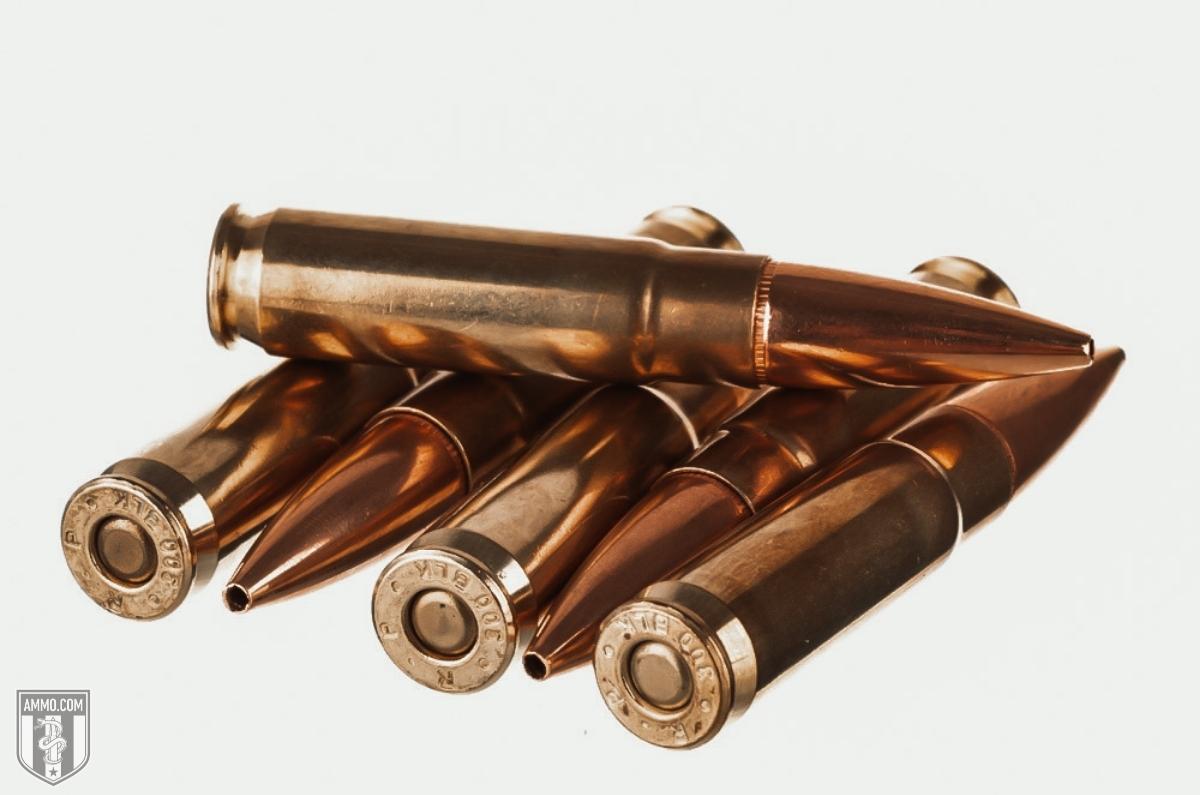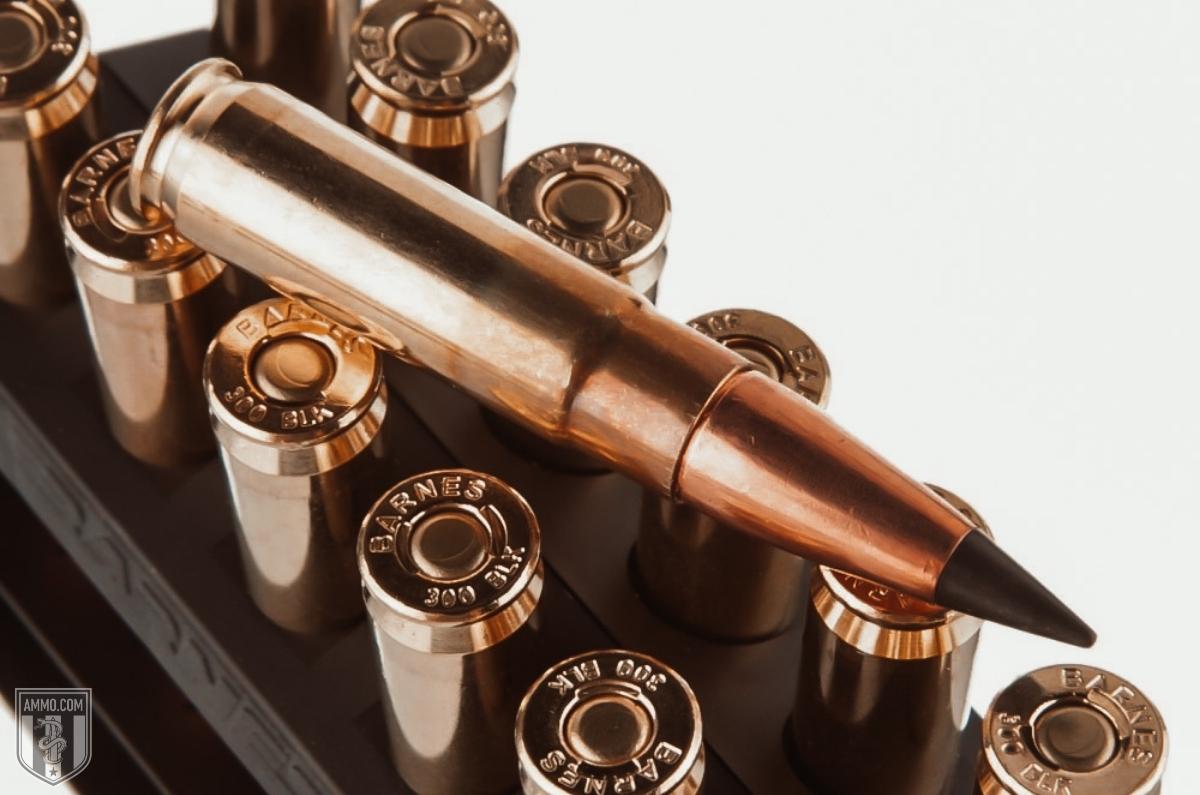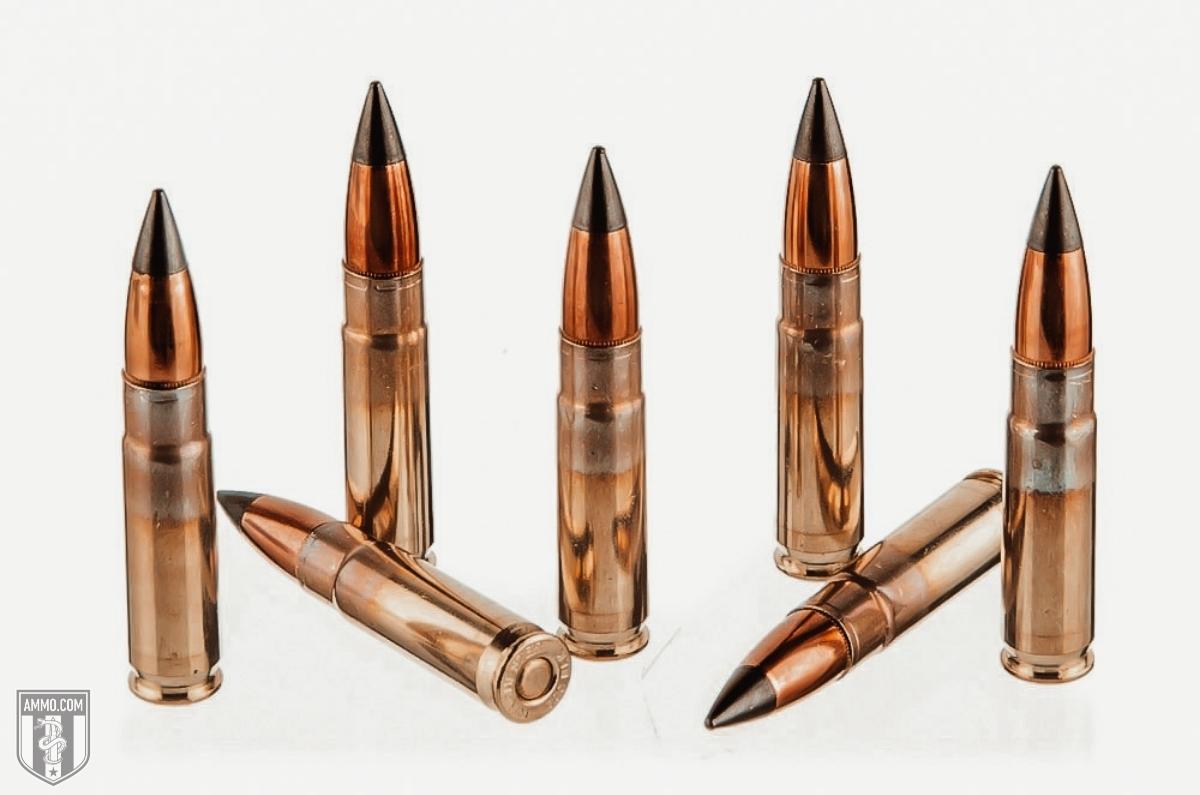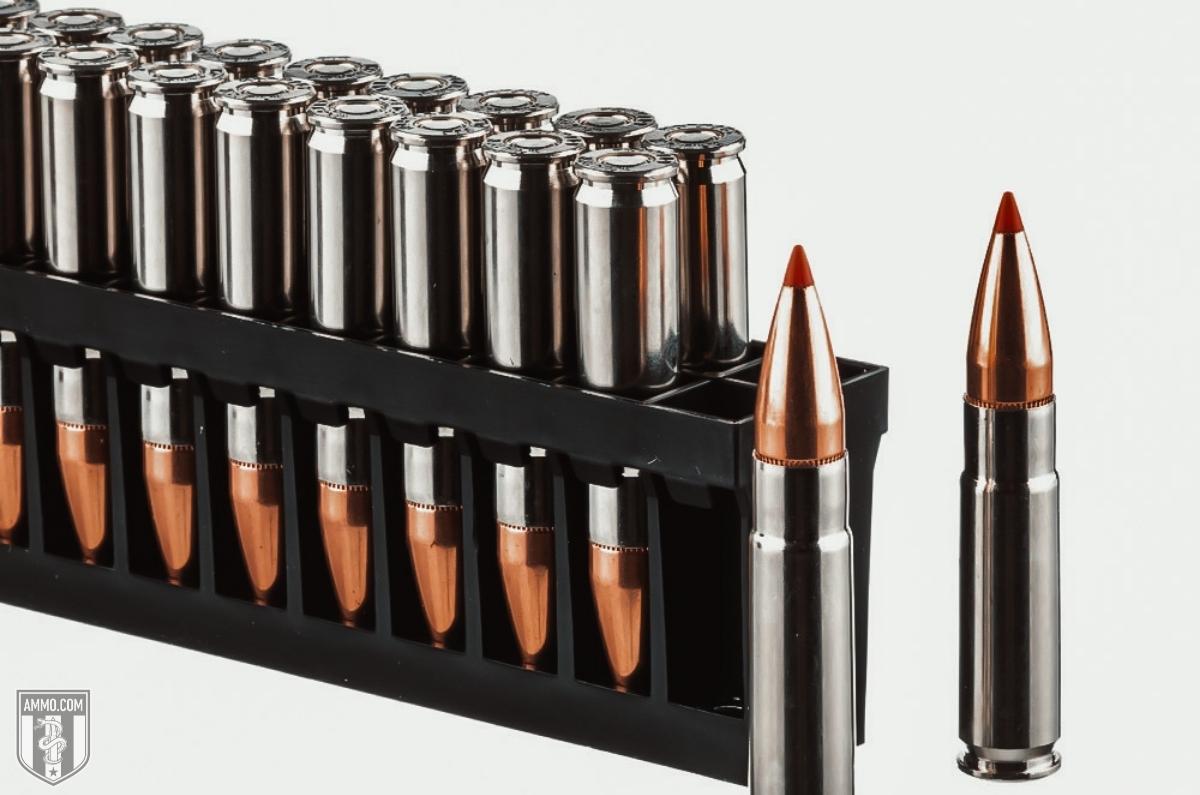300 Blackout vs 308 Caliber Comparison: Why Intended Purpose Matters

The 300 AAC Blackout and 308 Winchester are both 30-caliber rifle cartridges that shoot a .308” diameter bullet. However, this is where the similarities end as both cartridges have a different intended purpose.
In this caliber comparison article, we are going to take a detailed look at both the 300 AAC Blackout and the 308 Winchester. Unlike previous articles, I won’t “crown a winner” because the difference between 308 vs 300 Blackout is comparing apples to oranges.
Instead, we will take a deeper look into what the intended purpose of each rifle cartridge is and how having versatility within a caliber is a good thing for you and the 2A community in general.
I don’t know about you, but I’m ready to rack the charging handle on my AR platform and squeeze the trigger on this comparison between 308 vs 300 Blackout. Let’s close distance and ENGAGE!
308 vs 300 Blackout: A Tale of Two 30’s
As we mentioned earlier, the only similarity between the 308 Winchester and 300 AAC Blackout ammo is that they both shoot the same .308” diameter bullet.
Each rifle cartridge was developed for a specific role and each excels at its intended role.
However, the two rounds could not be more dissimilar, and we will explore the differences below.
300 AAC Blackout: The Dark Ops Wishlist Given Form
The development of 300 AAC Blackout ammo (designated 300 BLK by SAAMI) rifle cartridge began in 2010 when Robert Silvers of the Advanced Armament Corporation (which was later acquired by Remington) was approached by a member of the US Military “dark ops” community.
The unnamed military customer came to him with a problem that Silvers was eager to solve.
With the widespread adoption of the 5.56x45mm NATO cartridge (civilian ammo designation: 223 Remington or 223 Rem) for the M4 carbine, US troops were having to use the round for both long range and close quarters combat.
Overall, some special forces units were unhappy with the stopping power that the 5.56 NATO and the 9mm (used in several SMGs) offered during close quarters combat and they wanted something that had more “oomph”. Something along the lines of the 7.62x39mm Soviet round fired through the AK-47.
However, there were some other requirements that this customer required as well:
- The rounds needed to fit into a standard STANAG AR-pattern magazine and maintain a 30-round ammo capacity
- The cartridge face must be the same as 5.56 NATO so a bolt change was not needed
- It had to shoot 30 caliber bullets and mimic the ballistic performance of the 7.62x39mm Soviet round
- The new rifle cartridge needed to be compatible with short barreled rifles (SBR, barrels under 16”) and be completely functional with a suppressor/silencer
- Both supersonic and subsonic varieties of ammo needed to be functional for long range shots as well as close quarters battle, respectively
However, Silvers was not dismayed, and he returned to AAC to begin work on a new cartridge that would meet all these needs. The search for a host cartridge had begun.
Attempts to integrate new calibers into the AR platform were nothing new to the shooting community. The adaptation of the 6.8 Remington Special Purpose Cartridge (SPC) and 6.5 Grendel into the AR platform were mildly successful; however, they fell short of the mark in several key areas.
The 6.8 SPC and the 6.5 Grendel have a larger case head than the 5.56 NATO cartridge, so a new bolt was required for the host carbine.
Secondly, although both cartridges could be loaded into a standard capacity AR-15 magazine, they could not be loaded to 30 rounds because of the increased case size.
Colt Firearms and other manufacturers had been unsuccessful in adapting a 30-caliber cartridge to the M4 carbine. Complicating matters, the M4 cannot be easily modified to simply shoot 7.62x39 Soviet either as the severe case angle causes multiple chambering issues using a standard M4 magazine.
As Silvers continued his hunt to find a proper host cartridge for his new round, he started looking at different wildcat cartridges in the shooting community.
The 300 Whisper was probably the best wildcat cartridge that Silvers encountered, and it eventually became the host for the 300 BLK. That being said, the 300 Whisper could not simply be adapted to be fired from an AR platform because it did not have standardized loadings with SAAMI (Sporting Arms and Ammunition Manufacturers’ Institute).
As AAC/Remington was a SAAMI company, it could not load 300 Whisper ammo. Therefore, Silvers took the concepts from the 300 Whisper and modified them to meet their design specifications.
The new round was called the 300 AAC Blackout (300 BLK) and was approved by SAAMI on January 17, 2011.
300 BLK Ammo Specs
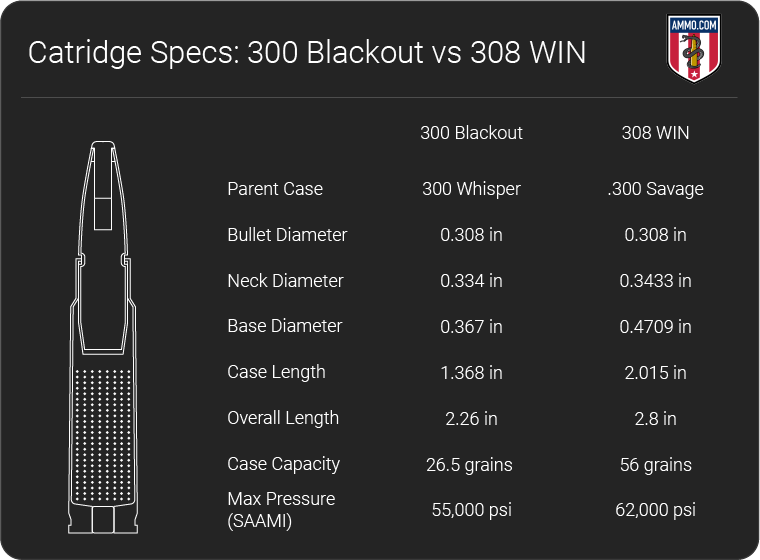
Since its approval by SAAMI in 2011, the 300 BLK has exceeded expectations in almost every category.
With an overall case length of 35mm, the 300 BLK has a case capacity of approximately 19.2 grains. The reduced case length was required to allow it to fit into a standard M4 carbine magazine while being loaded with a longer 30 caliber bullet.
300 BLK ammo can be broken down into two different bullet weights, 220 grain subsonic and 110 to 125 grain supersonic.
Supersonic ammo, typically firing a 125 grain bullet, will have a muzzle velocity of approximately 2250 fps and have a muzzle energy of around 1404 ft-lbs. Industry standards list the effective range of the supersonic 125 grain bullet loadings to be 500 yards.
In contrast, subsonic ammo will fire a 220 grain bullet and have a muzzle velocity of around 1000 fps and a muzzle energy of 488 ft-lbs with an effective range of 200 yards.
These two popular loadings really illustrate the versatility of 300 BLK ammo. With a simple magazine change, a shooter can switch from supersonic ammunition and long-range engagements to subsonic ammunition for short range combat.
Furthermore, the 300 BLK was designed specifically to experience a full powder burn when being fired in a 9” short barreled rifle (SBR), preferably with a suppressor/silencer.
308 Winchester: The Tried-and-True Warhorse
The 308 Winchester (7.62x51mm NATO designation) has been in service with the US Military for over 60 years and is the quintessential hunting round for whitetail deer to black bear.
The development of the 308 Winchester began from the needs of the US Military to advance into a new realm of battle rifles similar to the STG-44 and the AK-47.
In 1952, the U.S. Military started developing a replacement for the long-serving 30-06 Springfield cartridge (military designation: M2 Ball or 7.62x63mm).
Although the 30-06 Springfield had honorably served through both World Wars and Korea, the US Military wanted to develop a new cartridge that was lighter and more suitable for fully automatic rifle fire.
With advancements in rifle powder technology and case design in the 1950s, the new 7.62x51mm NATO rifle round was able to achieve nearly identical ballistic performance as the 30-06 Springfield with a shorter cartridge case length and lower overall weight.
The US Army officially adopted the 7.62x51mm NATO round in 1958 and it has been in service ever since.
Although the 7.62x51mm NATO cartridge and its parent rifle, the M14, only saw limited frontline use in Vietnam before being replaced by the 5.56 NATO, the military was quick to adapt it to use in sniper operations and in fully automatic machine gun use.
With a massive effective range out to and beyond 800 yards, it didn’t take long for civilian firearms manufacturers to take notice of the new military round.
Winchester was the first to adapt the new cartridge to its Model 70 bolt action rifle, renaming the cartridge the 308 Winchester.
The 308 Winchester quickly rose to be THE long-range high velocity hunting round that had enough muzzle energy to stop a black bear in its tracks.
Since its acceptance by the hunting and competitive shooting communities, the 308 Winchester has been a staple at deer camps and F Class Shooting Competitions alike.
308 Winchester Ammo Specs
308 Winchester ammo is available in a delirium-inducing amount of bullet weights. From 55 grain all the way up to 220 grain weight bullets, you will never lack variety when it comes to selecting the best 308 round for your purpose.
With a 51 mm overall case length, the 308 Winchester offers a whopping 52 grain case capacity. This translates to a 150 grain bullet loading have a shoulder-bruising 2820 fps muzzle velocity and a muzzle energy of 2648 ft-lbs.
300 Blackout vs 308 Winchester: The Comparison
Although these calibers are two completely different rounds with differing modes of service, I wanted to give you a quick rundown of each rifle cartridge to explain the pros and cons.
Recoil
In this category, there is simply no contest. The 300 BLK wins by an absolute landslide having approximately 4x less recoil when compared to the 308 Winchester.
Now I know what you’re thinking, because I’ve thought it too…“Recoil shouldn’t matter, just tough it out and focus on the shooting fundamentals!”
And I’ll say that on paper, you’re probably right. However, this rarely happens in the field.
Shoulder fatigue is a real problem when firing for long periods or trying to line up follow-up shots. Once this happens, a shooter will start encountering recoil anticipation, trigger jerk and over-correction; causing their down range accuracy to suffer.
When it comes to recoil, the 300 Blackout is clearly the better option.
Ballistics
We’ve produced some absolutely sick ballistics tables for you a little further down in this article, but I wanted to share a few highlights for you here.
When it comes to ballistics coefficient, the 308 Winchester is the clear winner when comparing to the 300 Blackout supersonic ammunition. With an average BC of around 0.45, the 308 Winchester is clearly the winner as 300 BLK ballistic coefficients typically below 0.4.
In terms of bullet drop and velocity (fps), the 308 is clearly the winner here as well. But this shouldn’t surprise you too much as the 308 was specifically designed to be effective at longer-range.
Home Defense
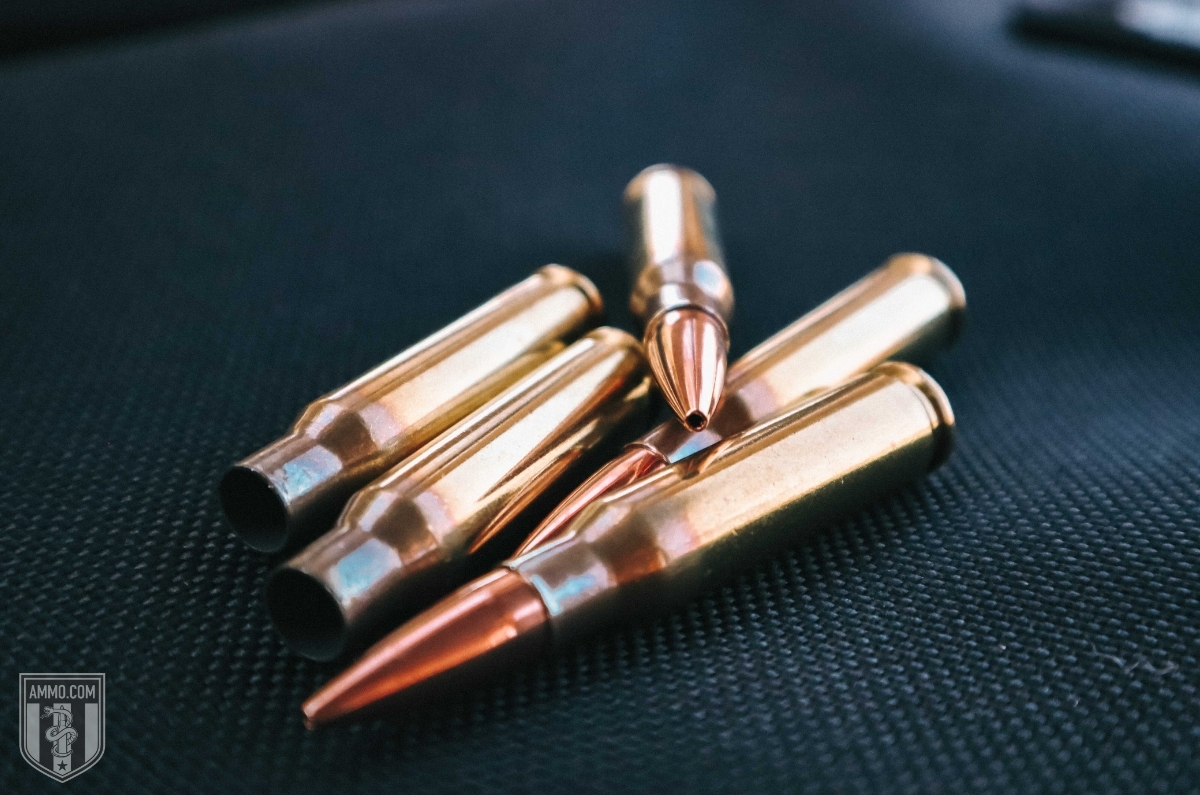
Both the 308 Win and the 300 BLK will serve you well in any self-defense situation. However, there is one critical thing to consider when discussing close range engagements.
And that critical issue is: Overpenetration
The 300 BLK was specifically designed to be shot in a SBR with a suppressor, which makes the 300 Blackout the better choice for indoor, short range engagements.
Furthermore, the 200 to 220 grain subsonic ammo is a partial safeguard against overpenetration as it will begin to lose velocity rapidly when it enters a target.
Compare this with the 308 Winchester freight train that might end up blasting through 2-3 suburban houses (and potential innocent bystanders) before even blinking an eye.
Remember, “Every bullet you fire has a lawyer attached to it” as my first shooting instructor was fond of saying. Therefore, we must carefully consider overpenetration when shooting in close quarters for self-defense.
This makes the 300 BLK the ideal home defense choice with its low recoil (faster follow-up shots), AR platform integration (modularity and light weight), short barrel compatibility, ease of sound suppression, and 30-round magazine capacity.
Suppressor Integration
Again, the 300 BLK is the clear winner here as it was specifically designed to be used with a suppressor.
One of the coolest things I’ve ever seen/heard is a subsonic 300 BLK being fired suppressed. It’s literally “movie gun” quiet.
You know what I’m talking about right?
When James Bond whips out his suppressed AR-15 or KRISS Vector and starts blasting away in full auto and all you hear is the sound of the wind…
Yeah, it doesn’t work like that in real life.
There are two things which make a bullet loud: the explosion of the powder and the “sonic crack” of the bullet breaking the sound barrier.
A silencer can greatly reduce the sound of the powder explosion, but if the bullet is supersonic, there will still be a “crack” of the bullet breaking the sound barrier.
BUT!
If you’re shooting subsonic ammunition, there is no “crack” because your bullet never broke the sound barrier.
With this in mind, you can effectively shoot hearing safe with a 300 BLK, a suppressor, and subsonic rounds.
Long-Range Shooting and Accuracy
Again, there is no comparison in this category as the 308 Winchester clearly dominates.
With its massive case capacity, high velocity, lower bullet drop, higher ballistic coefficient, and massive effective range, the 308 dominates the long-range shooting scene when compared to the 300 BLK.
However, this should not come as a surprise and the 308 Winchester is specifically designed for long-range shooting.
300 Blackout vs 308 for Hunting
I wanted to discuss hunting applications as a separate topic as this is one area where there is some controversy in the shooting community.
RecoilYeah, I know we talked about this already, but it bears repeating here as it is a factor to consider.
With 4x less recoil, the 300 AAC Blackout is going to be a lot more forgiving when it comes to making follow-up shots and this can be the difference between ethically harvesting an animal and having a wounded animal escape.
Rifle AvailabilityIn this category, the 308 is the clear winner as it has been around for over 60 years and has seen wide-spread hunting success.
Almost every rifle manufacturer will have an offering in 308 Winchester. In comparison, 300 BLK is a relatively new kid on the playground and there are fewer offerings.
However, many manufacturers are warming up to the 300 Blackout and more rifles are being offered. You can even get a Ruger Mini-14 in 300 BLK now!
Still, there are going to be hundreds of bolt action and semi-automatic options for 308 Winchester hunting rifles, so 308 gets the nod here.
Ammo Varieties308 Winchester takes this one as well. From the Barnes Varmint Grenade to the Hornady InterLock to a Nosler Partition, there are literally about as many varieties of 308 Winchester ammo as 223 Remington.
As 300 Blackout has only been around for about 10 years, there are fewer varieties of ammo available on the broader market for hunting.
Effective RangeThis one can be a little deceptive as it is easy to just say, 308 wins it because it can shoot out past 800 yards. But when you consider that, you need to ask yourself a question:
Can you ethically take an animal at 800 yards?
I’m going to wager that a most responsible hunters will not be comfortable taking a shot at a game animal at that range.
With that in mind, I think it is safe to say that this one is a wash between the two rifle cartridges as most ethical hunting shots will be taken under 400 yards.
Stopping PowerThis is a category where the 308 Winchester really shines. With a whopping 2648 ft-lbs of muzzle energy, the 308 Winchester clearly has more stopping power than a 300 BLK.
Does that mean that a 300 Blackout is ineffective as a hunting round? Not at all!
However, I would say that it would not be ethical to hunt anything larger than a whitetail deer with a 300 BLK as penetration and energy drop off significantly out past 400 yards.
A Note on 300 AAC Blackout Subsonic Ammo and Hunting
Reports from the field have shown less than stellar penetration data from the use of subsonic ammunition on medium size game animals, such as feral hogs and whitetail deer.
It is the recommendation of this writer that only supersonic ammo be used for hunting with 300 BLK on medium sized game animals.
Subsonic rounds should be sufficient to take down small varmints such as coyotes, groundhogs, etc.
300 Blackout vs 308: Ballistics
The real proof is in the numbers, right?
Well, our amazing team here at Ammo.com has whipped up some solid ballistics tables for you to compare the 300 Blackout vs 308 Winchester.
300 Blackout Ballistics
Note: This information comes from the manufacturer and is for informational purposes only. The actual ballistics obtained with your firearm can vary considerably from the advertised ballistics. Also, ballistics can vary from lot to lot with the same brand and type load.
| 300 Blackout Bullet WEIGHT | Muzzle VELOCITY (fps) | Muzzle ENERGY (ft. lbs.) | TRAJECTORY (in.) | |||||||||||
|---|---|---|---|---|---|---|---|---|---|---|---|---|---|---|
| Muzzle | 100 yds. | 200 yds. | 300 yds. | 400 yds. | Muzzle | 100 yds. | 200 yds. | 300 yds. | 400 yds. | 100 yds. | 200 yds. | 300 yds. | 400 yds. | |
| 110 Grain | 2150 | 1886 | 1646 | 1432 | 1254 | 1128 | 869 | 661 | 501 | 384 | 0 | -8.3 | -29.6 | -67.8 |
| 125 Grain | 2250 | 2031 | 1826 | 1636 | 1464 | 1404 | 1145 | 926 | 743 | 595 | 0 | -7 | -24.4 | -54.8 |
| 220 Grain | 1000 | 968 | n/a | n/a | n/a | 488 | 457 | n/a | n/a | n/a | 0 | n/a | n/a | n/a |
308 Ballistics
Note: This information comes from the manufacturer and is for informational purposes only. The actual ballistics obtained with your firearm can vary considerably from the advertised ballistics. Also, ballistics can vary from lot to lot with the same brand and type load.
| 308 Winchester Bullet WEIGHT | Muzzle VELOCITY (fps) | Muzzle ENERGY (ft. lbs.) | TRAJECTORY (in.) | |||||||||||
|---|---|---|---|---|---|---|---|---|---|---|---|---|---|---|
| Muzzle | 100 yds. | 200 yds. | 300 yds. | 400 yds. | Muzzle | 100 yds. | 200 yds. | 300 yds. | 400 yds. | 100 yds. | 200 yds. | 300 yds. | 400 yds. | |
| 55 Grain | 3770 | 3215 | 2726 | 2286 | 1888 | 1735 | 1262 | 907 | 638 | 435 | -2 | 1.4 | -3.8 | -15.8 |
| 110 Grain | 3165 | 2830 | 2520 | 2230 | 1960 | 2447 | 1956 | 1551 | 1215 | 938 | 1.4 | 0 | -6.9 | -20.9 |
| 120 Grain | 2850 | 2497 | 2171 | n/a | n/a | 2164 | 1662 | 1256 | n/a | n/a | 0 | -2.8 | n/a | n/a |
| 150 Grain | 2820 | 2533 | 2263 | 2009 | 1774 | 2648 | 2137 | 1705 | 1344 | 1048 | 2.5 | 0.4 | -8.5 | -26.1 |
| 150 Grain Superformance | 3000 | 2772 | 2555 | 2348 | 1962 | 2997 | 2558 | 2173 | 1836 | 1540 | 1.5 | 0 | -6.9 | -20 |
| 155 Grain | 2775 | 2553 | 2342 | 2141 | 1950 | 2650 | 2243 | 1887 | 1577 | 1308 | 1.9 | 0 | -8.3 | -24.2 |
| 155 Grain | 2850 | 2640 | 2438 | 2247 | 2064 | 2795 | 2398 | 2047 | 1737 | 1466 | 1.8 | 0 | -7.5 | -22.1 |
| 165 Grain | 2700 | 2440 | 2194 | 1963 | 1748 | 2670 | 2180 | 1763 | 1411 | 1199 | 2.5 | 0 | -9.7 | -28.5 |
| 168 Grain | 2680 | 2493 | 2314 | 2143 | 1979 | 2678 | 2318 | 1998 | 1713 | 1460 | 2.5 | 0 | -8.9 | -25.3 |
| 168 Grain Super Match | 2870 | 2647 | 2462 | 2284 | 2114 | 3008 | 2613 | 2261 | 1946 | 1667 | 1.7 | 0 | -7.5 | -21.6 |
| 170 Grain | 2000 | 1740 | 1510 | n/a | n/a | 1510 | 1145 | 860 | n/a | n/a | 0 | 0 | 0 | 0 |
| 178 Grain | 2620 | 2415 | 2220 | 2034 | 1857 | 2713 | 2306 | 1948 | 1635 | 1363 | 2.5 | 0 | -9.6 | -27.6 |
| 178 Grain Super Match | 2780 | 2609 | 2444 | 2285 | 2132 | 3054 | 2690 | 2361 | 2064 | 1797 | 1.8 | 0 | -7.6 | -21.9 |
| 180 Grain | 2620 | 2393 | 2178 | 1974 | 1782 | 2743 | 2288 | 1896 | 1557 | 1269 | 2.5 | -0.2 | -10.2 | -28.5 |
Conclusion
In closing, I think that the differences between 300 AAC Blackout and 308 Winchester are pretty clear.
The 308 Winchester is a wildly successful hunting and long-range shooting round that has a 60+ year track record behind it. It was specifically designed to have superior stopping power, high velocity, and a long effective range and it does all these things in spades.
The 300 Blackout round was designed to be fired primarily from AR pattern rifles and excels in short barrels and is easily suppressed. Requiring only a barrel change to convert an AR-15 to 300 Blackout is a huge plus, considering it utilizes the same bolt and magazines, a conversion is rather inexpensive.
Both rifle rounds serve a different purpose when it comes to your shooting needs and so understanding the differences is key before making your purchase.
If you’re looking for a lightweight, short barrel, home defense carbine then the 300 Blackout fits the bill. The ability to reliably use subsonic ammo makes it an ideal self-defense cartridge as it has low recoil and allows for quick follow-up shots.
The 300 Blackout also is extremely versatile as it allows for quick transitions to supersonic ammo to take long-range shots out to 500 yards and can easily take medium to small size game animals.
However, if you’re looking to really “stretch your legs” and shoot longer range, then the 308 Winchester has your back and will give you the range, stopping power, and high velocity that you need to reach out to 800+ yards.
Regardless of your choice, buying in bulk is always smart! Make sure to check out our stock of 300 blackout bulk ammo and bulk 308 ammo.
Are you ready to go out and purchase your 300 Blackout rifle? I know I am! But my 308 bolt action rifle is never going to leave my gun safe either because caliber variety really lets you pick the right tool for the right job. And variety, my friends, is the spice of life (AND shooting!)
Ammo Comparisons
- .308 vs 5.56
- 6.5 Creedmoor vs .308
- .300 Blackout vs .308
- .300 Win Mag vs .308
- .243 vs .308
- .308 vs .30-06
- 7mm-08 vs .308
- .270 vs .308
- 7.62x39 vs .308
- .223 vs .308
- .338 Lapua vs .308
- .380 ACP vs 9mm
- .223 vs 5.56
- .300 Blackout vs 5.56
- 9mm vs 45 ACP
- 9mm vs 40 S&W
- .357 SIG vs 9mm
- 10mm vs 9mm
- 9mm vs 9mm Luger
- .243 vs .270
- .300 Win Mag vs .30-06
- .270 vs .30-06
- .40 vs .45
- 38 Special vs 357
- 9mm vs 40 vs 45
- 5.56 vs 7.62x39
- 338 Lapua vs .30-06
- .30-30 vs .30-06
- 300 PRC vs 338 Lapua
- .30-06 vs 7mm
- 300 Win Mag vs 338 Lapua
- 300 PRC vs 300 Win Mag
- 300 WSM vs 300 Win Mag
- 338 Win Mag vs 338 Lapua
- 12 Gauge vs 20 Gauge
- 10mm vs 357 Mag
- .30-30 vs 7.62x39
- 224 Valkyrie vs 22-250
- 17 HMR vs 22 Mag
- 7.62x39 vs .300 Blackout
- 45 ACP vs 45 Auto
- 45-70 vs 30-30
- 300 Blackout vs 223
- 357 Magnum vs 9mm
- 350 Legend vs 300 Blackout
- 224 Valkyrie vs 223
- 45 ACP vs 38 Super
- 6.5 Grendel vs .308
- 17 HMR vs 22 LR
- 10 Gauge vs 12 Gauge
- 22-250 vs 223
- 45 Colt vs 45 ACP
- 350 Legend vs 30-30
- 5.7x28 vs 223
- 5.7 vs 9mm
- 5.56 vs 5.7
- 22 vs 9mm
- Buckshot vs Birdshot
- 450 Bushmaster vs 308
- 450 Bushmaster vs 223
- Buckshot vs Slug
- 6.5 Grendel vs 5.56 vs 223
- 6mm ARC vs 6.5 Grendel
- 44 vs 45
- 458 SOCOM vs 5.56
- 357 vs 44
- 32 ACP vs 380
- 300 Win Mag vs 338 Win Mag vs 338 Lapua Mag
- 450 Bushmaster vs 458 SOCOM vs 50 Beowulf
- 6mm Creedmoor vs 6.5 Creedmoor
- TMJ vs FMJ
- 44 Special Vs 44 Magnum
- 45 90 vs 45 70
- 6.8 Western vs 6.8 SPC
- 50 Beowulf vs 50 BMG
- 26 Nosler vs 6.5 PRC
- 28 Gauge vs 410
- 6.8 SPC vs 5.56
- 6.8 SPC vs 6.5 Grendel
- 6.8 Western vs 7mm Rem Mag vs .28 Nosler
- 6.8 Western vs 6.5 Creedmoor
- 22 Hornet vs 223
- 6.8 Western vs 6.5 PRC
- .410 vs 12 Gauge
- .410 vs 20 Gauge
- 22 LR vs 22 Mag
- 6mm ARC vs 243
- 7mm-08 vs 270
- 243 vs 6.5 Creedmoor
- Nickel vs Brass Casing
- 204 Ruger vs 223
- 50 Beowulf vs 5.56
- 260 Remington vs 6.5 Creedmoor
- 6mm Remington vs 243
- 28 Nosler vs 300 PRC
- 50 Beowulf vs 50 AE
- 22 Nosler vs 22-250
- 450 Marlin vs 45-70
- 300 Win Mag vs 300 Norma
- 458 SOCOM vs 300 Blackout
- 38-55 vs 45-70
- 22 Hornet vs 22 LR
- 300 Norma vs 338 Lapua
- 338 Lapua vs 50 BMG
- 28 Nosler vs 300 Win Mag
- 28 Nosler vs 6.5 Creedmoor
- 204 vs 22-250
- 458 SOCOM vs 45 70
- 44 40 vs 45 70
- 6.8 SPC vs 6.5 Creedmoor
- 450 Bushmaster vs 30-06
- 7mm Rem Mag vs 300 Win Mag
- 30 Carbine vs 223
- 25-06 vs 30-06
- 26 Nosler vs 28 Nosler
- 16ga vs 12ga
- 30 06 vs 7.62 x54R
- 9mm Makarov vs 9mm Luger
- 350 Legend vs 223
- 30 Carbine vs 5.56
- 6.5x55 vs 6.5 Creedmoor
- 6.5 Creedmoor vs 270 vs 25-06
- M193 vs M855
- 450 Bushmaster vs 458 SOCOM
- 6.5 Grendel vs 6.5 Creedmoor
- 350 Legend vs 5.56
- .277 Fury vs 6.8 SPC
- 277 Fury vs 300 Win Mag
- 10mm vs .45 ACP
- 277 Fury vs 223
- 6.8 SPC vs 300 Blackout
- 6.5 PRC vs 6.5 Creedmoor
- 277 Fury vs 308
- 277 Fury vs 6.5 Creedmoor
- 350 Legend vs 450 Bushmaster
- 277 Fury Vs 5.56 NATO
- 10mm vs 40S&W
- 32 ACP vs 9mm
- 32 Special vs 9mm
- 8.6 Blackout vs 300 Blackout
- 30 Super Carry vs. 9mm
- 5.56 vs 9mm
- .50 Action Express vs 9mm
- 7.62x25 vs. 9mm
- 10mm vs 44 Magnum
- 300 Blackout vs 300 Win Mag
- 6.5 Grendel vs 300 Blackout
- 460 Rowland vs 10mm
- 300 RUM vs 300 PRC
- 300 Norma vs 300 PRC
- 45 GAP vs 45 ACP
- 7mm PRC vs 300 Win Mag
- 300 PRC vs 6.5 Creedmoor
- 300 PRC vs 308
- 357 SIG vs 357 Mag
- 7.62x39 vs 7.62x51
- 243 Win vs 223 Rem
- 30 Nosler vs 300 PRC
- 6.5 Creedmoor vs. 30-06 Springfield
- 450 S&W vs. 44 Magnum
- 6.5 Creedmoor vs. 300 Win Mag
- 454 Cassull vs. 45-70 Govt
- 454 Cassull vs. 44 Mag
- 7.62x54r vs. 308 Winchester
- 22 ARC vs. 223 Rem
- Subsonic vs. Supersonic Ammo
